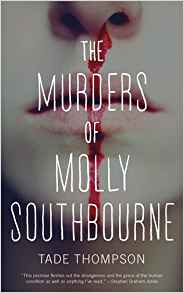African SFF 2017 by Geoff Ryman
 2017 was a year of small watersheds and consolidations, rather than breakthroughs for African speculative fiction.
2017 was a year of small watersheds and consolidations, rather than breakthroughs for African speculative fiction.
Roughly 40 short speculative fiction stories were published in magazines and anthologies, according to Wole Talabi’s database on the African Speculative Fiction Society website.
In some ways it was a year of sales to international markets. Wole Talabi, Cat Hellesin, and Dare Segun Falowo had important stories published in F&SF. Jordan Ifueko wrote “Oshun Inc” for Strange Horizons, who also published Kerstin Hall’s “Bombyx Mori”. Tor.com Publishing published a new novella The Murders of Molly Southbourne by Tade Thompson.
Galaxies issue 46 edited by Pierre Gévart was devoted to African SFF with translations from Anglophone authors of the level of Lesley Arimah, Diane Awerbuck, Sofia Samatar, Wole Talabi, and Nnedi Okorafor and francophone contributions by Mame Bougouma Diene, Moussa Ould Ebnou, and others. The Manchester Review Issue 18 (edited by me) consisted mostly of reprints to build a history of African SFF. It included two original stories by Masimba Musodza (in English and ChiShona) and Kofi Nyameye.
In Africa itself, Omenana published two issues this year. The September issue carried fiction by authors who were in many cases already establishing reputations: Eugene Odogwu, Nerine Dorman, Lillian Aujo, Hannah Onuguwe, and Ekari Mbvundula. The April issue carried a slightly higher proportion of newer writers, including Toby Bennett, Alvin Kathembe, Anne Dafeta, and Prossy Bibangambah.
Short Story Day Africa’s 2017 anthology on the theme of Migration had no fewer than eight fantasy stories from the likes of Blaize Kaye, Sibilonge Fischer, and Mary Okoporonto. Odaka Books published the third installment of Eugene Odogwu’s Fall Town Fables series, ‘Saint Skinnerman’s Blues’.
Saraba magazine produced its first anthology, Transitions, which included at least two stories with speculative elements by Irenosen Okojie and TJ Benson.
Brittle Paper gave African SFF great support on its critical pages, but towards the end of the year seemed to be publishing more comment and less fiction – they published two speculative stories, one by Stanley Onyewuchi, the other by Osahon Ize-Iyamu.
The Writivism collective, organizers of four annual literary festivals in Uganda, published their anthology, Sun Rise and Other Stories, named after Innocent Immaculate Acan’s 2016 prize winning science fiction story. Walter Dinjo’s Sub Sahara magazine did not appear, nor did Jungle Jim.
In January, Will This Be a Problem? arrived. This is the third anthology from the blog of the same name co-founded by Kevin Rigathi. It was a by-definition speculative fiction anthology, coming out of Nairobi but pan-African in intention. Andrew C. Dakalira, who had a novella in AfroSFV2, starts the anthology with “The Rise of the Akafula”. The other contributors include Lausdeus Otito Chiefboka, James Kariuki, Michelle Angwenyi, and others. Like so much publishing on the continent, including Omenana, Brittle Paper, and comics publishers Vortex 247 and The Comic Republic, this anthology is available online for free.
Publishing by Africans for Africa in Africa is not easy. Nor is finding audiences in Africa, and making SFF by Africans for Africans pay publishers or writers. Informally Chiagozie Nwonwu estimates that roughly 90% of visits to the Omenana website come from outside the continent.
Awards are one key way to validation for African writers. This year’s Caine Prize nominees included Chikodili Emelumadu for her story “Bush Baby”, first published at the end of 2015 in the anthology African Monsters edited by Margret Helgadottir, and Lesley N. Arimah for “Who Will Greet You at Home”. This was Arimah’s second year running for the Caine, both stories SFF and both stories published in The New Yorker, no less.
The Gerald Kraak Award shortlisted Dilman Dila’s speculative story “Two Weddings for Amoit” for its 2017 Award. At the end of the year, the shortlist for this next year’s award was announced, including “The Man at the Bridge” by sometimes-fantasy author Kiprop Kimutai.
It has not been a bumper year for SFF novels by Africans. Deji Bryce Olukotun’s “futuristic thriller” After the Flare was listed by Kirkus Review and Tor.com as one of the best books of 2017. Gavin Chait’s Our Memory Like Dust followed up his first novel Lament for the Fallen. Fred Strydom’s The Raft (2015) was a criminally neglected, straight up literary-SF novel. His new novel, The Inside Out Man, is said to have a Hitchcockian flavour, with aspects of Edgar Allan Poe and H.P. Lovecraft. Marcus Low’s near-future Asylum was a notable debut. Henrietta Rose-Innes launched Green Lion, about an attempt to resurrect an extinct species of lion. Masha du Toit published The Real. The redoubtable Sarah Lotz returned with The White Road, a novel about clickbait journalism and something like a ghost.
If you are an African hoping to publish an SFF novel, it helps to be South African or to live abroad. In South Africa speculative fiction from black writers finally seems to be surfacing. Narcisse Sadi, writing as Elcid or Elsiddi, produced Lai Tai a speculative fiction novella. In December 2016, Phumlani Mhlanga’s novel The Journey of Two-Boy appeared and TQ Zama published the fantasy novella Skyborn.
Nnedi Okorafor continued to gain recognition – the third Binti novella was announced and the Nigerian edition of Who Fears Death was launched at the Ake Festival. The news that George R.R. Martin was involved with an HBO TV series version of Who Fears Death, and that Nnedi is now writing for Marvel Comics, made headlines in Nigeria.
The Nommo Awards were fortunate to have Nnedi there to present these first ever awards for speculative fiction by Africans. The winners were: for the Ilube Nommo Award for Best Novel, Rosewater by Tade Thompson. Best novella was Binti by Nnedi Okorafor. The short story award was an exact tie between T.L. Huchu for “The Marriage Plot” and “Who Will Greet You at Home?” by Lesley Nneka Arimah. The best graphic novel went to Chronic #3: “The Corpse Exhibition”, from the Chimurenga collective. The full list of nominations and a video of the award ceremony are available on <www.africansfs.com>.
This article and more like it in the February 2018 issue of Locus.
 While you are here, please take a moment to support Locus with a one-time or recurring donation. We rely on reader donations to keep the magazine and site going, and would like to keep the site paywall free, but WE NEED YOUR FINANCIAL SUPPORT to continue quality coverage of the science fiction and fantasy field.
While you are here, please take a moment to support Locus with a one-time or recurring donation. We rely on reader donations to keep the magazine and site going, and would like to keep the site paywall free, but WE NEED YOUR FINANCIAL SUPPORT to continue quality coverage of the science fiction and fantasy field.






